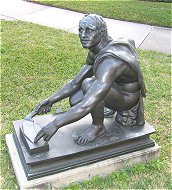ArrotinoMuseum Label: Chiurazzi description: |
Subject info:
This statute was first recorded in a drawing by Marten van Heemskerck, who was in Rome
between 1532 and 1536. By 1536 it belonged to Niccolo Guisa in Rome. In 1567 Duke Cosimo
de Medici was trying to buy it through the agency of Vasari and 12 years later it was
acquired. Many copies in marble and bronze have been made for the rich and famous since
its discovery.
The earliest references describe the figure in the most neutral terms: "a knife sharpener" (arrotino) and a "villano" (peasant). till the end of the 17th century. But either the expression of the figure itself or a belief that all statues must represent some specific individual, very quickly encouraged scholars to search for a more satisfying designation. Many stories and explanations were circulated in the mid seventeenth century. One popular explanation was that it represented the freed Milichus who showed Nero the dagger which he had been instructed by his master Flavius Scaevinus to sharpen in preparation for the Emperor's murder. In the middle of the 19th century it was generally accepted that the Arrotino was waiting instructions from Apollo to begin flaying Marsyas alive, who had been defeated by the god in a musical contest.
Some distinguished scholars stated that the work was of the Renaissance period and because of its quality must have been made by Michelangelo. However, it is now generally accepted that the sculpture is an original Pergamese marble (200 BCE? Western Turkey, now Greece) of the highest quality.
Other entry:
This piece is from Pergamon and shows a Scythian servant (from Southern Russia) in a squat
position sharpening a knife possibly to be used by Apollo to flay alive the Satyr,
Marysas. Scythia is called the region to the north and northeast of the Black Sea. Mount
Caucasus, where Prometheus 1 was nailed and kept bound for many years, is a Scythian
mountain. Scythia is the abode of one of the WINDS, the North Wind Boreas 1. The
inhabitants of this region called themselves Skoloti, but the Greeks called them Scythians.
There were three main clans among the Scythians, deriving from the three sons of their
ancestor Targitaus.
The Scythians were believed to lead a bestial way of life; therefore, as they became the
proverbial barbarians, other people could express themselves thus:
"It is not Scythians who committed such deeds, but the people who claim to excel
in love of mankind have by their decrees utterly destroyed these cities."
[Diodorus Siculus, Library of History 13.30.7]
Others add that the Scythians had a law that sentenced all men of sixty years of age to
death.
